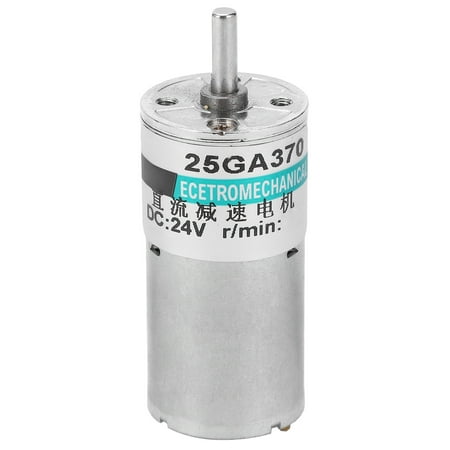Low Speed Motor DC Gear Motor Micro Low Speed CW CCW Permanent Sport Control 24V XD-25GA370


sku: 3494245550
ACCORDING TO OUR RECORDS THIS PRODUCT IS NOT AVAILABLE NOW
$13.93
Shipping from: United States
Description
low speed motor DC Gear Motor Micro Low Speed CW CCW Permanent Sport Control 24V XD-25GA370 Specification: Item Type: DC Gear Motor Model: XD-25GA370 Material: Copper Output Shaft Size: Approx. 4 x 12mm / 0.2 x 0.5in Insulation Resistance: After the rated operation of the motor under normal temperature and humidity when measuring the insulation resistance between the coil and the motor shell with a DC500V resistance meter it does not exceed 20 milliohm Insulation Withstand Voltage: After the rated operation of the motor under normal temperature and humidity 50Hz or 60Hz is applied between the coil shells for one minute and the abnormality is 1500V. Temperature Rise: It is normal to install a gear box or equivalent heat sink and conduct rated operation under normal temperature and humidity by using the resistance method to measure the temperature rise of the coil below 70 degrees Celsius Insulation Class: Class B130 degrees Celsius Operating Environment Temperature: Motor: -10~+40 degrees Celsius no icing Use Environment Humidity: 85% or less no condensation CW/CCW: Yes Speed Adjusted: Yes Model Voltage(DC/V) No-Load Speed rpm/min No-Load CurrentA Load Speed rpm/min Loading Moment(kgf·cm) Load Current(A) Power(W) XD-25GA370 24V 100 0.05 93 0.47 0.2 2 200 0.05 175 0.23 0.2 2 300 0.05 245 0.16 0.2 2 500 0.05 485 0.05 0.2 2 Notes: 1 Overload and Locked Rotor: When the motor is running it generates heat due to the energy conversion that occurs inside the coil and the iron core and the temperature gradually rises. The load is within the rated range and the heat generation and heat dissipation are balanced and the coil of the motor will not be burnt. However it will cause heat under overload and locked-rotor conditions. When the running time is too the insulating film on the enameled wire of the coil is dissolved causing a short circuit between the enameled wires and burning the motor. 2 When Running at Low Speed: For DC motors carbon brushes are generally used. The rotating commutator rubs against the carbon brushes creating sparks at the notches of the commutator. When the motor is running at a low speed the carbon brush powder that is easily generated by the friction between the commutator and the carbon brush will accumulate in the commutator slot causing a short circuit and burning the motor and driver. Please be very careful. 3 Precautions on the PWM Controller: When using the PWM controller the carbon brushes have a shorter service life than in the rated voltage or fixed voltage state. In addition depending on the frequency of use carbon brushes may wear out quickly. The frequency of PWM control of DC motors is generally 10-20KHz and repeated ON-OFF during PWM control can save energy. However the parts used in the motor are similar to the frequency of use which will cause resonance and heat. Please pay full attention to use. In the PWM control state when using the built-in motor of the electrolytic capacitor the motor may not rotate at a certain fixed frequency. Please try to use varistor to hide the motor. Need to do related tests 4 Regarding Inertia and Braking: After the motor is powered off the rotor will still rotate due to inertia which is the inertia of the DC motor. If you want to stop the rotation
Price history chart & currency exchange rate
Customers also viewed

$31.71
Washing Machine Drain Pad Dust Cover Waterproof Oven Microwave Refrigerator Fridge Protector Mat Coffee Drain Pad Table Placemat 20x30cm
joom.com
$3.14
Type-c Rechargable Mini Portable Waterproof Electric Shaver Strong High Speed Long Endurance Suitable Wet and Dry
aliexpress.com
$0.43
1/2 Inch Garden Brass Hose Adapter Converter Connector Watering Water Hose Pipe Tap Adaptor Fitting Hub
aliexpress.com
$104.96
Space heel super high heel 17cm thin heel sexy custom leopard print high heel open toe sandals for men and women
aliexpress.com
$98.24
New Portable MY272BTS Bluetooth 5.3 Speaker 1500mAh Ultra Long Battery Life HIFI Sound Bass Surround Portable Bluetooth Speaker
aliexpress.com
$51.35
20X 4S 12V 100A Protection Circuit Board Lifepo4 Bms 3.2V With Balanced Ups Inverter Energy Storage Packs Charger
aliexpress.com
$53.00
Genuine Leather Mary Jane Pumps Thick Bottom Round Toe Square Heel Soft Bottom One Foot Stirrup Half Slippers Retro Versatile
aliexpress.com
$275.24
Customize Outdoor gazebo Courtyard Aluminum alloy pavilion outdoor sun room Garden house Villa flip louver electric pergola
aliexpress.com
$1.95
Multi-function Car Seat Purse Hook 2 In 1 Car Bag Holder Mobile Phone Holder Hanger Holder Hook For Bag Purse Cloth Grocery
aliexpress.com
$19.50
foridol casual summer camis blouse shirt women lace up shoulder boho beach crop sleeveless ruffled blouse 210415, White
dhgate.com
$119.26
u1 aaa luxurys high-end quality fashion watches fully automatic mechanical movement date dial male clock men 42mm women 36 overs style depth, Slivery;brown
dhgate.com
$10.32
men shoulder chest bag nylon waterproof outdoor sport running cycling belt bag large capacity travel phone pouch bags
dhgate.com
$87.63
summer 2018 fashion convenient fashion brand dress singers new snow jeans man jeans splashink nightclubs men 5614 uujeo4561712, White;black
dhgate.com
$0.84
Kawaii Sanrios Hellokittys PompomPurins My Melody Pochacco Cinnamoroll Cartoon Anime Paper Notebook Decoration Card Sticker Set
aliexpress.com
$22.43
Stainless Steel Polished Bathroom Towel Rack Pinch-Free Folding Movable Bath Towel Shelf Holder Bathroom Basket Holder
aliexpress.com
$20.59
ZWY765 Fashion Toddler Kids Baby Girls Clothes Leopard Bib Braces Overalls Sleeveless Dresses Outfit Baby Summer Clothing 1-7Y
aliexpress.com
$50.99
women's sweaters loose and lazy style leopard knitted coat women's autumn winter wear medium length sweater cardigan hong kong fla, White;black
dhgate.com
$4.11
Чехол силиконовый противоударный Silicone Cover Full without Logo (A) для Realme C11 Бордовый / Marsala
prom.ua
$15.33
Эротический женский белый бодистокинг с цветочками на все тело ТМ PASSION. Сексуальный комплект для девушек
prom.ua















